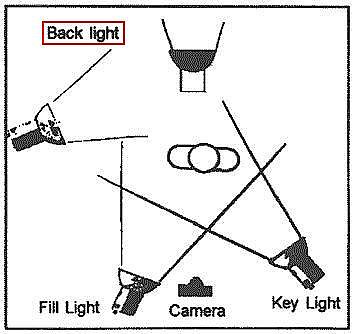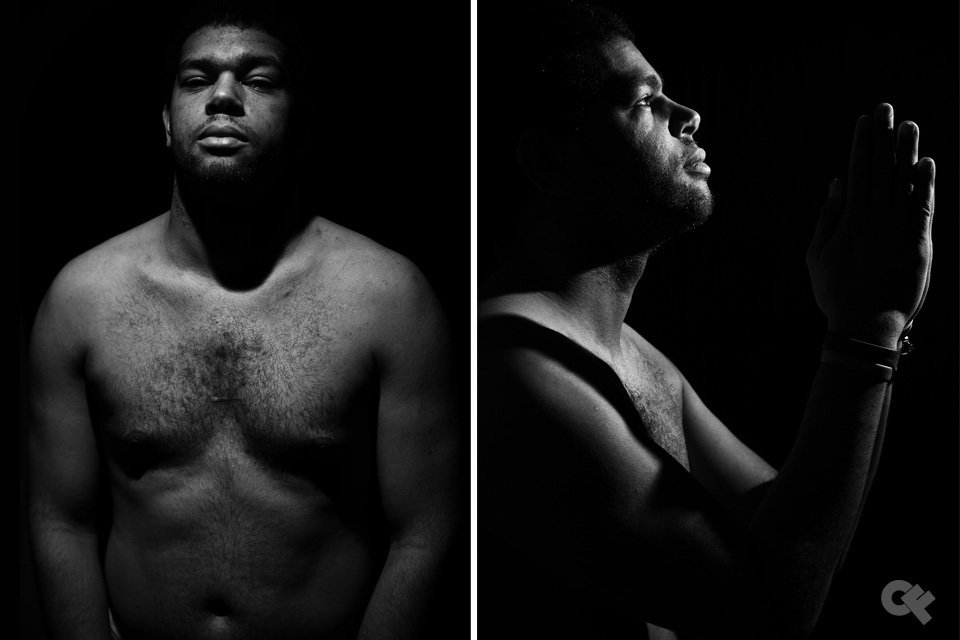Lighting
Lighting is a prime factor within the film industry. It is used to enhance the picture on screen as in effective in declaring clarity within media productions. Without lighting, films can often appear dark and thus unprofessional, which makes it mandatory to have appropriate lighting when shooting sequences in film. However, lighting can be used in different styles to manipulate and give the picture on screen a particular look. The image below is an example of a standard lighting set up:
These different styles of lighting put together in this particular set up is effective as the it creates an overall light that presents the subject on screen to a clear and better quality than without the lighting. Breaking down the separate aspects of this lighting set up, there are names for each separate element of the set up as follows.
Key light
The Key light in film is known as the first, brightest and arguably the most influential, however, this varies based on many relevant factors within the filming i.e. the subject. The key light's main function is to effectively portray the form and dimension of a subject on screen so that it has a specific effect on the audience. Positioning of the key light is also very relevant with a focused picture that can be described in film terms as "hard" and a diffused shot on screen which can be described as "soft". Normally in a three point lighting set up, the key light is normally at a 30 - 60 degree angle from the camera, however, the level that the key light stands can be varied to embrace different effects. An example of this is a low level key light can make out a silhouetted effect in which the subject on screen can appear mysterious and thus the audience only see their movements and not too much of their appearance. In contrary, a high angle key light can be effectively used to present the subject on screen with a greater appearance and present and the audience can relate more to other features of the subject such as facial expressions and subtler gestures. The key light can also be affected by different factors such as background and colour.
In the media industry, Fill light plays a major role as it is used to reduce the contrast of a scene to match the dynamic range of the recording media. It is effective as it is used to diminish shadows and dark spots that can be created from key and back light in the three point lighting set up. From a picture on screen that would be considered as normality, an increased or decreased use of Fill light can allow shadows and darkness to show greater on screen or reduce darkness on screen making it an effective way of provoking the audience to feel a certain way when watching the action on screen. Furthermore, the fill light in correlation with the key light is an artificial way of creating an illusion of natural fill when the fill light is positioned on the camera with the key light in its normal position. The fill light is most commonly positioned to the right or occasionally left hand side of the camera where it is at a similar degree angle as the key light around 30 - 60 degrees, however, the positioning of a fill light is strongly based on what type of effect the lighting cameraman or cinematographer is after. Overall, the fill light is effective as it corresponds with the other factors of the three point lighting set up in order to portray a subject on screen in a certain way to provoke audience reaction, based on its movement and positioning and how it manipulates the features on screen.
Back Light
The back light translates into the phrase "light from behind" where the light is emitted from behind the subject present on screen. The back light alike the fill and key light is part of the three point standard lighting set up. The back light's key function is to counteract the effect of the key light and thus sustain a balanced picture on screen in relation to the subject. The back light can be used to create a rim of light around the subject from behind and thus placing emphasis on different parts of the body such as hair, shoulders and other extremities. The back light is important as it levels out the overall picture within a three point lighting set up. However, on its own, the back light directly behind a subject will create a silhouette of the subject with their features not visible to the audience. This can therefore be effective for specific genres of film such as horrors or thrillers with an intense vibe as the back light can create tension and suspense and cause an essence of mystery for the action to have a great effect on the audience.

Under Lighting
Under lighting is an effective lighting tool used in film to inject the action with suspense, tension and mystery where the main source of light comes from under the subject and thus illuminates specific parts of the subject such as their face leaving facial shadows which causes the subject to appear vague and unclear which can make the audience feel confused, intimidated and frightened by the subject which is a major reason why this use of light is often seen prominently in thrillers and horrors where suspense and intensity are two major factors involved in the content of the film. This demonstrates how under lighting can manipulate features of the subject to provide a scary effect for the media production and its audience.
Top Lighting
Top lighting refers to the lighting source that comes from a source above the subject, and is often from the left hand side for specific effect. The top light from the left hand side can traditionally preserve a contrasting convex-concave ambiguity so that the audience can become suspicious of the subject on screen and the effect can even be to the extent of confusion. This is effective especially in genres such as thrillers where there is a need for factors such as tension and suspense which can be created from aspects such as ambiguity. Top lighting is used in a more modernised way, straight from above the subject where it efficiently highlights the features of the subject which can make the person or object on screen appear glamorous and therefore desirable
Low Key Lighting
Low key lighting is another key element in film and the media. It is used to manipulate the picture on screen to create a specific effect for the action on screen and the audience that will be spectating. LKL is done through using a single key light in a position that placates the cinematographer for the sequence on screen with the occasional input of a fill light or a reflector. LKL can also be held responsible for the Chiaroscuro effect within film where the contrast between dark and light areas on the subject can highlight important or relevant aspects of a picture and can also provide the picture on screen or an image with a certain volume which can make a 2 dimensional image appear relatively 3 dimensional. Furthermore, low key lighting is accompanied by a dark background to sustain the effect of a mysterious and darkened atmosphere of the shot.
High Key Lighting
High Key lighting is evidently the opposite of Low Key lighting where there is a much greater use of fill lighting accompanied with the key light so that the lighting ratio is affected to create the right effect for the cinematographer. The higher the lighting ratio, the higher the contrast of the image, the lower the lighting ratio, the lower the contrast of the image. Overall, HKL accompanied with a bright background creates a very realistic feel to the image on screen where the audience understand that the action or picture is very naturalistic and the audience can strongly relate to it as being a representation of the "real world." Contrary to this, extreme HKL can be used to develop an on screen environment where it appears very abstract almost spiritual. An example of this would be an extreme white background and necessary construction on screen to portray.
Nosferatu
The film Nosferatu, made in 1922 relied dominantly on the use of lighting with much of the action taking place using pure lighting to fulfil the scary effect of the film. This is evidence that lighting has played a major role in film throughout history. Without modern day effects and graphics to create a certain effect for a film, filmmakers in the early 20th century had to be resourceful and develop techniques of portraying or creating a desired effect without advanced editing and graphics and lighting played a vital role in sustaining horror and mystery throughout film. In this specific film, most of the action on screen was supported by low key lighting to sustain mystery and suspense for 1920s audiences to feed off of while watching.
Film Noir
Film Noir is French terminology which translates into "Black film" created by Nino Frank and is used to describe a group of Hollywood films from the early 1940s to the late 1950s which focused on many cynical attitudes and sexual motivations of the time period and the films are normally classed as a representation of the dark and more sinister side to humanity. Films regarded as Film Noir use Low key lighting throughout most, if not all of the film. This makes the film appear black and white and the lack of colour and the predominant dark nature of the picture reflects the action taking place, with most of the action in Film Noir productions being very dark and sinister and to some degree even misogynistic.










No comments:
Post a Comment